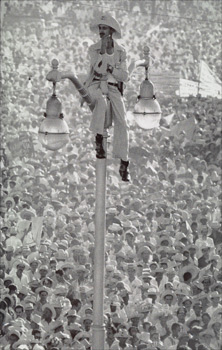Los Angeles County Museum of Art ,
Apr 15, 2001 - Jul 01, 2001
Los Angeles, CA, USA
Exhibition Review
by LatinArt.com
The Los Angeles County Museum of Art (LACMA) exhibits revealing work by three generations of Cuban photographers that highlights the continuing and extraordinary achievements of Cuba's artistic community as well as the social and political changes in Castro's Cuba. Shifting Tides: Cuban Photography after the Revolution, includes more that 100 poignant black and white and color photographs. The exhibition is on view from April 15 through July 1, 2001. Certain photographs transcend the circumstances of their making. They become emblematic of an era, of a generation, or of a geographic place. Dorothea Lange's 1936 photograph Migrant Mother has attained mythic status and become visually synonymous with the Depression and the migration of Dust Bowl refugees to California. The raising of the flag on Iwo Jima as portrayed by Joe Rosenthal was immediately recognized as the essence of the experience of World War II and the heroism and patriotic verve of those Americans who served. The danger with this type of "branding" is that it tends to foster the conception that all photography of the period reflects the same ideological grounding of the lone iconic image and also the image becomes the benchmark against which subsequent images of the period or place are measured. Such is the case with Guerillero Heroico by Alberto Diaz Gutierrez (Korda). Korda's image was taken on the occasion of a memorial service for victims of a maritime explosion in Havana harbor. The image captures a sullen and pensive Che Guevarra stoically looking beyond the camera's gaze as if into the distance, into the future. It has become emblematic not only of the revolution that toppled the previous Battista regime, but also of the revolutionary ethic of the period and of Cuba itself. The images became the single most identifiable example of Cuban photography. Organized into three sections with a prologue gallery, the exhibition will elucidate the shifting social, political, and personal concerns that have fueled the artistic expressions of artists using photography over the past 40 years in Cuba. "One of the reasons I did Shifting Tides was to expand the common perception of what Cuban photography is generally thought o be," stated curator Tim B. Wride. "That is, black-and-white documentary, reportage with a hint of magical realism, and replete with iconic images of Che and Fidel. What the exhibition will demonstrate is the broad range and inventive nature of work, both conceptual and visual, that has been and continues to be done on the island. The work is expressive, sophisticated, and firmly grounded in an international art dialog."
|





